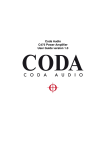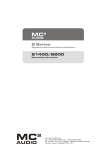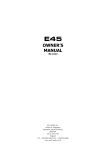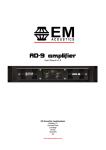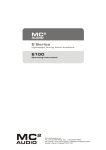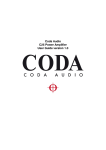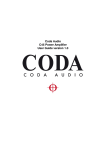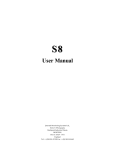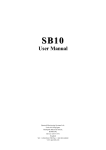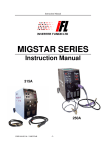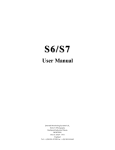Download MC2 Audio E4-75 Owner`s manual
Transcript
E4E4-75 OWNER’S MANUAL 2 MC AUDIO Ltd., Units 6-8, Kingsgate, Heathpark Industrial Estate, HONITON, Devon EX14 1YG England Tel: +(0)1404.44633 Fax: +(0)1404.44660 www.mc2-audio.co.uk CONTENTS EC DECLARATION OF CONFORMITY 3 IMPORTANT SAFETY INSTRUCTIONS 4, 6, 7 INSTALLATION 4 5 5 Electrical RF Emissions Mechanical GENERAL INFORMATION 8 CONNECTIONS Inputs Outputs Bridged Operation 8 9 9 OPERATION Switching on Level controls Limiters Signal level indicators PRC indicators Temperature control Fault indicator 11 11 11 11 11 11 12 MAINTENANCE 12 TECHNICAL SPECIFICATION 13 NOTE THAT ALL AMPLIFIERS* BEFORE SERIAL NUMBER 7E70004 HAVE A DIFFERENT WIRING CONFIGURATION FOR THE INPUT AND OUTPUT SOCKETS. THIS WILL ONLY AFFECT THE ‘LINKED’ OR ‘BRIDGED’ MODES OF OPERATION. * Serial numbering for the E4-75 commenced with 6E7..... 2 3 IMPORTANT SAFETY INSTRUCTIONS 1) Read these instructions. 2) Keep these instructions. 3) Heed all warnings. 4) Follow all instructions. 5) Do not block any ventilation openings and install in accordance with the manufacturer’s instructions. 6) Unplug this apparatus during lightning storms or when unused for long periods of time. 7) Clean only with a dry cloth. 8) Do not use this apparatus near water; the apparatus shall not be exposed to dripping or splashing and no objects filled with liquids, such as vases shall be placed on the apparatus. 9) Refer all servicing to qualified service personnel. Servicing is required when the apparatus has been damaged in any way, such as if the power-supply cord or plug is damaged, liquid has been spilled or objects have fallen into the apparatus, the apparatus has been exposed to rain or moisture, does not operate normally, or has been dropped. INSTALLATION INSTRUCTIONS - ELECTRICAL This amplifier has been manufactured to comply with your local power supply requirements but, before connecting the unit to the supply, ensure that the voltage (printed on the rear panel) is correct. Make sure power outlets conform to the power requirements listed on the back of the unit. Damage caused by connecting to improper AC voltage is not covered by the warranty. SAFETY WARNING Where a MAINS plug or appliance coupler is used as the disconnect device, it should remain readily operable. Where the amplifier is mounted in a rack and permanently connected to the mains, then the rack should be installed with a readily accessible connector or an ALL POLE circuit breaker. This unit is fitted with a 3-wire power cord. For safety reasons THE EARTH LEAD SHOULD NOT BE DISCONNECTED IN ANY CIRCUMSTANCE. If ground loops are encountered, consult the section on ‘Input Connections’ later in this manual. THE WIRING COLOURS ARE: 230V AREAS: EARTH = GREEN AND YELLOW NEUTRAL = BLUE LIVE = BROWN WARNING 120V AREAS: EARTH = GREEN NEUTRAL = WHITE LIVE = BLACK To reduce the risk of fire or electric shock, do not expose this apparatus to rain or moisture. TO AVOID ELECTRICAL SHOCK DO NOT REMOVE COVERS. REFER ALL SERVICING TO QUALIFIED PERSONNEL. 4 DO NOT USE THE UNIT IF THE ELECTRICAL POWER CORD IS FRAYED OR BROKEN. The power supply cords should be routed so that they are not likely to be walked on or pinched by items placed upon or against them, paying particular attention to cords and plugs and the point where they exit from the appliance. ALWAYS OPERATE THE UNIT WITH THE AC GROUND WIRE CONNECTED TO THE ELECTRICAL SYSTEM GROUND. Precautions should be taken so that the means of grounding of a piece of equipment is not defeated. DO NOT REMOVE THE LID. Removing the lid will expose you to potentially dangerous voltages. There are no user serviceable parts inside. INSTALLATION EMC (RF Emissions) The high frequency resonant converters in the E Series amplifiers have been designed to have very low radio frequency (RF) emissions, which can cause interference with other equipment. In order to reduce the influence of this, Power Amplifiers should be mounted in a dedicated metal rack enclosure, which does not include equipment which may be sensitive to RF radiation, such as radio microphone receivers. INSTALLATION MECHANICAL To ensure that this equipment performs to specification, it should be mounted in a suitable rack or enclosure as described below. Like all high power amplifiers, it should be kept away from other equipment which is sensitive to magnetic fields or RF radiation. Also, this amplifier may suffer a substantial reduction in performance if it is subjected to, or mounted close to, equipment which radiates high RF fields, such as power transmitters. When mounting the amplifier in a rack or enclosure, ensure that:1. the rear of the unit is adequately supported. The brackets which are supplied fit standard 19 inch (483mm) rack mounting systems. THE FRONT PANEL IS NOT CAPABLE OF SUPPORTING THE UNIT ON ITS OWN; 2. THERE IS ADEQUATE VENTILATION. The cooling fans suck cool air in through the front and blow hot air out at the rear of the unit through the ventilating grills. IF THIS AIR IS NOT ALLOWED TO ESCAPE, OVER-HEATING WILL OCCUR. Take care when mounting other equipment in the same rack; 3. the rack unit has a separate earth connection (technical earth). ALSO SEE MAINTENANCE SECTION, page 9. 5 WARNING: Apparatus with CLASS I construction shall be connected to a MAINS socket outlet with a protective earthing connection. WARNING: To prevent injury, this apparatus must be securely attached to the rack in accordance with the installation instructions. 1. Read these instructions. 2. Keep these instructions. 3. Heed all warnings. 4. Follow all instructions. 5. Do not use this apparatus near water. 6. Clean only with a dry cloth. 7. Do not block any ventilation openings, install in accordance with the manufacturer’s instructions. 8. Do not install near any heat sources, such as radiators, heat registers, stoves or other apparatus (including amplifiers) that produce heat. 9. 14. Refer all servicing to qualified service personnel. Servicing is required when the apparatus has been damaged in any way, such as if the power-supply cord or plug is damaged, liquid has been spilled or objects have fallen into the apparatus, the apparatus has been exposed to rain or moisture, does not operate normally, or has been dropped. 15. Do not expose this equipment to dripping or splashing and ensure that no objects filled with liquids, such as vases, are placed on the equipment. 16. To completely disconnect this equipment from the AC mains, disconnect the power cord from the mains circuit breaker. 17. Where the amplifier is mounted in a rack and permanently connected to the mains, then the rack should be installed with a readily accessible connector or an ALL POLE circuit breaker with 3mm breaking distances. Protect the power cord from being walked on or pinched particularly at plugs, convenience receptacles and the pint where they exit from the apparatus. 18. This unit is fitted with a 3-wire power cord. For safety reasons, THE EARTH LEAD SHOULD NOT BE DISCONNECTED IN ANY CIRCUMSTANCE. 10. The mains circuit breaker shall remain readily accessible. 11. Only use attachments/accessories specified by the manufacturer. 19. The cooling fans suck cool air in through the front and blow hot air out at the rear of the unit through the ventilating grills. The front and rear of the amplifier should have free exposure to the air (i.e. in a rack leave the front and rear doors off), with 2cm air gap at the sides and top. IF AIR IS NOT ALLOWED TO ESCAPE FROM THE REAR, OVER-HEATING WILL OCCUR. Take care when mounting other equipment in the same rack. 12. Use only with the cart, tripod, bracket or table specified by the manufacturer, or sold with the apparatus. When a cart is used, use caution when moving the cart/apparatus combination to avoid injury from a tip over. 13. Disconnect this apparatus during lightning storms or when unused for a long period of time. 20. The mains switch on the amplifiers only switches one pole of the mains supply, therefore for units with a detachable cord to be fully disconnected from the mains, the mains disconnect device (ie mains plug or mains coupler) should remain readily operable. For units with a fixed mains lead the external all pole circuit breaker with 3mm breaking distances is the disconnect device and therefore the installation of the amplifier shall be carried out in accordance with all the applicable installation rules. 6 ATTENTION: Appareils de construction de CLASSE I doit être raccordé au réseau électrique via une prise de courant reliée à la terre. ATTENTION: Pour éviter toute blessure, cet appareil doit être solidement fixé à la torture, conformément aux instructions d'installation. 1. Lisez ces instructions. 2. Gardez ces instructions. 3. Faites attention à tous les avertissements. 4. Suivez toutes les instructions. 5. N'utilisez pas cet appareil près de l'eau. 6. Faites le ménage seulement avec un tissu sec. 7. Ne bloquez pas d'ouvertures de ventilation, installez conformément aux instructions du fabricant. 8. N'installez près d'aucunes sources de chaleur, comme les radiateurs, les registres de chaleur, les cuisinières ou d'autre appareil (en incluant des amplificateurs) qui produisent la chaleur. 9. Protégez la corde de pouvoir d'être marché sur ou pincé particulièrement aux prises de courant, les réceptacles d'avantage et la pinte où ils sortent de l'appareil. 10. Le disjoncteur de conduite principale restera sans hésiter accessible. 11. Utilisez seulement des attachements/accessoires spécifiés par le fabricant. 12. Utilisez seulement avec le chariot, le trépied, la parenthèse ou la table spécifiée par le fabricant, ou vendu avec l'appareil. Quand un chariot est utilisé, utilisez la prudence en déplaçant la combinaison de chariot/appareil pour éviter la blessure d'un bout. 13. Débranchez cet appareil pendant les tempêtes de foudre ou quand neuf pendant un long terme de temps. 7 14. Renvoyez tout l'entretien au personnel de service qualifié. L'entretien est exigé quand l'appareil a été nui de toute façon, comme si la corde de pouvoir provision ou la prise de courant sont nuis, le liquide a été déversé ou les objets sont tombés dans l'appareil, l'appareil a été exposé pour pleuvoir ou l'humidité, n'opère pas normalement, ou a été baissé. 15. N'exposez pas cet équipement au fait de tomber goutte à goutte ou au fait d'éclabousser et garantissez qu'aucun objet rempli des liquides, comme les vases, n'est placé sur l'équipement. 16. Pour complètement débrancher cet équipement de la conduite principale de courant alternatif, débranchez la corde de pouvoir du disjoncteur de conduite principale. 17. Où l'amplificateur est monté dans un égouttoir et en permanence raccordé à la conduite principale, alors l'égouttoir devrait être installé avec un connecteur sans hésiter accessible ou TOUT le disjoncteur de PÔLE avec 3 millimètres cassant des distances. 18. Cette unité est correspondue avec une corde de pouvoir de 3 fils. Pour les raisons de sécurité, l'AVANCE DE TERRE NE DEVRAIT ÊTRE DÉBRANCHÉE DANS AUCUNE CIRCONSTANCE. 19. Les ventilateurs engloutissent l'air frais par le front et soufflent l'air chaud à l'arrière de l'unité par les grils aérants. Le front et l'arrière de l'amplificateur devraient avoir l'exposition libre à l'air (c'est-à-dire dans un égouttoir omettent les portes de devant et arrière), avec le trou aérien de 2 centimètres aux côtés et au haut. Si on NE PERMET PAS QUE D'AIR S'ÉCHAPPE DE L'ARRIÈRE, LE FAIT DE SURCHAUFFER SE PRODUIRA. Faites attention en montant d'autre équipement dans le même égouttoir. 20. L'interrupteur principal sur les amplificateurs ne coupe qu'un pôle de l'alimentation secteur. le cordon IEC permettra de déconnecter l'appareil de l'alimentation secteur, pour cette raison l'accès à ces fiches (fiche mâle ou femelle) doit être facilités. Pour les appareils avec un câble d'alimentation fixe sans fiche secteur, le dispositif de coupure omnipolaire ayant une distance d'ouverture de contact d'au moins 3mm, sera le dispositif permettant la déconnexion complète de l'appareil. Pour cette raison l'installation et le raccordement de l'amplificateur devra ce faire conformément au réglementation en vigueur. GENERAL INFORMATION Your E4-75 power amplifier utilises proprietary designed load impedance sensing output circuitry, which enables the amplifier to drive the high voltage swings associated with speaker impedances of 8 ohms and above, but automatically switches to a high current/medium voltage output required by 4 ohm loads. Fan speed is varied as required to keep the amplifier within its temperature limits. Signal limiters are included to protect speakers from clipped signals. The amplifier includes full DC and short circuit protection to ensure trouble-free service even in ‘harsher’ environments. The E SERIES introduces three user-controlled features previously not seen on MC2 Audio amplifiers: Bar LED level indicators on the front panel. Power reduction control (PRC) User-settable gain/sensitivity (internal) Power Reduction Circuit (PRC) and Impedance Sensing There are two PRC circuits in the E4-75: one for channels A & B and one for channels B & C. When the amplifier is to be used with 4 ohm speakers (or bridged mono into 8 ohms) or if you want to reduce the maximum power to protect the speakers, then the PRC can be selected via the switches on the rear panel. Whenever an audio signal of medium amplitude is present on any channel and, if the speaker impedance on any of the channels is less than 5.5 ohms, then the Automatic Impedance Sensing circuit will set that pair of channels to the 4 ohm position. CONNECTIONS NOTE THAT ALL AMPLIFIERS BEFORE SERIAL NUMBER 7E70004 HAVE A DIFFERENT WIRING CONFIGURATION FOR THE INPUT AND OUTPUT SOCKETS. THIS WILL ONLY AFFECT THE ‘LINKED’ OR ‘BRIDGED’ MODES OF OPERATION. INPUTS The inputs are made via 3-pin XLR connectors, which are electronically balanced and should be connected via a high grade twin core screened cable, as follows:Pin 1 - Screen (see note) Pin 2 - +ve signal (hot) Note: +ve and –ve denotes the phase of the signal 8 Pin 3 - -ve signal (cold) The amplifier is designed to operate with fully balanced equipment and ground loops or loss of performance may be experienced if connected to unbalanced sources. If it is unavoidable however, the following wiring should be used. The cable should still be twin core plus screen. Pin 1 - Screen - connected to the chassis of the unbalanced equipment - or left disconnected at the unbalanced end. Pin 2 - +ve signal Pin 3 - -ve signal Note: This amplifier is wired to the latest industry recommendations. PIN1 is connected directly to the chassis/mains earth. If ground loops (mains hum) are encountered remove the screen connection from the other end of the cable and leave it open circuit. If problems persist, consult your dealer/supplier. DO NOT TAMPER WITH OR ALTER ANY GROUND (EARTH) CONNECTIONS INSIDE THE AMPLIFIER. For BRIDGED OPERATION use channels A & B (or C & D). Inputs should be connected to channel A (or C). Pressing the A/B link switch (or C/D link switch) on the rear panel connects B amplifier to the A input (or the D amplifier to the C input). Input Link Switches. The three input link switches on the rear panel link the inputs of the channels to the one higher up the hierarchy ladder. So the following combinations can be achieved. A & B (input on A) B & C (input on B) A & B & C (input on A) B & C & D (input on B) A & B & C & D (input on A) C & D (input on C) This switching, together with internal crossover cards (optional extras) provides a wide variety of input connection options. OUTPUTS The speaker outputs are via Neutrik Speakon connectors: 2-pole (NL2FC) or 4-pole (NL4FC) connectors can be used. Terminations (all connectors) are as follows:Pin +1 = +ve signal output Pin -1 = -ve signal output For ease of installing bi-amped or bridged speakers, output connector A also carries output B and output connector C also carries output D. The terminations are as follows: Output connector A Pin +1 = +ve channel A Pin +2 = +ve channel B Pin -1 = -ve channel A Pin -2 = -ve channel B Output connector C Pin +1 = +ve channel C Pin +2 = +ve channel D Pin -1 = -ve channel C Pin -2 = -ve channel D For bi-amped operation connect as above. For bridged operation connect as follows: Channels A & B +ve = channel B +ve (pin +1 on connector B or +2 on connector A) -ve = channel A –ve (pin -1 on connector A) 9 Channels C & D +ve = channel D +ve (pin +1 on connector D or +2 on connector C) -ve = channel C –ve (pin -1 on connector C) Note: Both level controls must be set to the same position. When operating in bridged mode, the minimum impedances are 8 ohms. Note: 1. Negative (-ve) output terminals must not be joined together, since they are not both at 0V. 2. Because the currents involved are very high, the speaker cables should conform to the following minimum requirements, otherwise the losses will cause the cables to get hot and audio power will be reduced: E4-75 - 14A into 4 ohm speaker loads. 3. Do not connect the inputs/outputs to any other voltage source such as a battery, mains source or power supply, regardless of whether the amplifier is turned on or off. 3. Do not run the output of any amplifier channel back into another channel’s input and do not parallel or series-connect an amplifier output with any other amplifier output. 10 Operation SWITCHING ON At ‘switch-on’ the protection circuit will initially activate whilst the circuits stabilise. Assuming no faults are detected after a few seconds, the red A/P LED will go off. PANEL CONTROLS AND INDICATORS Level controls These are analogue controls allowing precise level settings. Note that in ‘BRIDGED’ mode, both level controls must be set to the same position. Limiters Each channel incorporates a high performance limiting circuit that prevents the outputs from ‘clipping’ when the maximum level is exceeded. They have been designed to be transparent to signals below this level and the attack and release times have been optimised for them to be unobtrusive when in operation. Level Indicators Each channel has an LED level ‘bar’, which shows green up to the -3dB point, then orange and finally a red limit LED. Note the limit LED has a different response time to the others and with fast transients, can be ‘on’ even though some of the lower level LEDs are not. PRC Indicators (green LED) These indicate when the PRC circuit, for the specific pair of channels, has been selected. (Either manually via the switches on the rear panel or automatically via the impedance sensing circuit) Temperature Control The cooling fans respond to temperature sensors within the unit to maintain a safe operating temperature. In the event of excessive temperature, the protection circuit will operate, disabling the output. The red ‘AUDIO-PROTECT’ (A/P) LED will indicate this condition. (See fault indicator). There are 4 fans connected permanently with variable speed and a jumper link to enable them from cold. Normal dynamic signals will not cause the amplifier to overheat unless the ventilation is inadequate. (See installation section and maintenance section.) 11 Fault Indicator (Audio Protection – red LED) If the outputs are shorted or if DC is present, the protection circuit will disengage the outputs and the A/P LED will illuminate. The amplifier will continue to be monitored and depending on the type of fault, will either reset after the fault has cleared or require manual resetting by switching off at the mains switch and then on again after a few seconds. (See also temperature control above.) Maintenance CAUTION: These servicing instructions are for use by qualified personnel only. Ensure that electrical power to the unit is disconnected before carrying out any maintenance. GAIN/SENSITIVITY SETTINGS Gain settings are changed internally by simple jumper links. Four rows of pins marked:- GAIN A, GAIN B, GAIN C and GAIN D - are situated on the input PCB (PCB721). A jumper link sets the gain and the settings are as follows: Link 1 & 2 Link 3 & 4 Link 4 & 5 gives gives gives 32dB gain 26dB gain approx. 31dB gain = 6dBu/1.5V sensitivity into 4 ohms NOTE: Factory setting is normally link 1 & 2 = 32dB gain. Setting higher gain does not change the maximum available power but changes the level of signal input to achieve maximum power. In any case, provided that the input signal is less than 20dBu/7.7V, the built in limiter circuit will prevent distortion within the amplifier. The gain should be set to match the signal from the source, e.g. mixer, controller, equaliser etc. AIR FILTER The filter behind the air intake apertures on the front of the E4-75 amplifier should be cleaned or replaced periodically, e.g. 3-6 months. (Filters in amplifiers located in more 'dirty' atmospheres may require more frequent maintenance.) Access is via the blue front panel. The filter should be 'dry' cleaned, using a vacuum cleaner preferably. Running the unit without a filter is not recommended unless it is within a 'clean room'. Replacement filter material is available. No other regular maintenance is required. If you have any doubt about carrying out this procedure, refer to a service engineer or contact your dealer. IF YOUR AMPLIFIER DEVELOPS A FAULT, PLEASE REFER TO YOUR SUPPLIER FOR SERVICE AND TECHNICAL SUPPORT. DO NOT ATTEMPT TO REPAIR THE FAULT YOURSELF AS THIS WILL INVALIDATE THE WARRANTY. 12 TECHNICAL SPECIFICATION Main Specifications - E series Amplifiers Parameter (Units) E90 E45 E25 E15 E100 E475 8 ohms 2500 1250 700 450 1400 775 4 ohms 4800 2500 1350 850 2800 900 2 ohms 8200 4200 2400 1550 3700 NA Output Power (per channel) (Watts) Output Power (bridged) ( Watts) 8 ohms 9600 5000 2700 1700 5300 1800 4 ohms 16400 8400 4800 3100 7400 NA @1kHz (@1dB below max output power) < 0.15 0.015 0.008 0.008 0.08 0.008 @20Hz to 20kHz (@3dB below max output power) < 0.5 0.05 0.03 0.03 0.15 0.03 32/36/39 26/32/36 26/32/33 26/31/32 26/32/36 26/31/32 THD+N:(%)(4 ohms) Gain Options (dB) Sensitivity Options (for maximum power) (dBu) Sensitivity Options (for maximum power) (Volts) Frequency Response - 20Hz to 20kHz (dB) Power Consumption: Nominal @ 240v (4 ohms)(Amps) Power Consumption: Nominal @ 120v (4 ohms)(Amps) 13/9/6 15.7/9.7/5.7 13/7/6 11/6/5 16/10/6 11/6/5 3.5/2.2/1.5 4.7/2.4/1.5 3.5/1.7/1.5 2.7/1.5/1.4 4.9/2.5/1.5 2.7/1.5/1.4 ±1.0 +0 / -0.3 +0 / -0.3 +0 / -0.3 ±0.5 +0 / -0.3 5.6 4.5 3 2.1 7 2.7 11.2 9 6 4.2 14 5.4 Dimensions: (mm) Amplifier: H x W x D 88 x 482 x 428 Boxed (shipping UK): H x W x D 230 x 580 x 560 Boxed (shipping - all except UK): H x W x D 250 x 610 x 600 Weight: (Kgs) Amplifier: 11.78 11.42 10.16 9.8 12 10.62 Boxed:(shipping) 13.78 13.42 11.92 11.66 14 12.62 Additional Specifications Input Impedance - Active balanced (k ohms) Input CMRR (dB) Hum & Noise (dB below max output) Damping Factor: @1kHz into 8 ohms Signal Limiters - (set to prevent excessive clipping) Protection: Short circuit / DC output / Temperature Mains in-rush control. Output Power (watts) into 8 ohms 20 20 20 20 20 20 >60 >60 >60 >60 >60 >60 -105 -106 -105 -105 -105 -105 >400 >400 >400 >400 >400 >400 Yes Yes Yes Yes Yes Yes Yes Yes Yes Yes Yes Yes Yes Yes Yes Yes Yes Yes Sine wave @ 1kHz 2400 1100 650 400 1150 725 Continuous music with Crest Factor of 2.8 (9dB) 2400 1200 675 425 1300 750 Continuous music with Crest Factor of 4.8 (14dB) 2500 1250 700 450 1400 775 Continuous music with Crest Factor of 7.8 (18dB) 2600 1350 725 475 1480 825 Output Power (watts) into 4 ohms Sine wave @ 1kHz 4500 2050 1200 775 2250 750 Continuous music with Crest Factor of 2.8 (9dB) 4400 2400 1250 825 2600 825 Continuous music with Crest Factor of 4.8 (14dB) 4800 2500 1350 850 2800 900 Continuous music with Crest Factor of 7.8 (18dB) 5000 2700 1350 875 2900 900 Output Power (watts) into 2 ohms Sine wave @ 1kHz 7200 3300 2200 1350 3200 NA Continuous music with Crest Factor of 2.8 (9dB) 6800 4100 2300 1500 3600 NA Continuous music with Crest Factor of 4.8 (14dB) 8200 4200 2400 1550 3700 NA Continuous music with Crest Factor of 7.8 (18dB) 8900 4300 2600 1600 3700 NA An internal link can be set to either 100V or 120V for the 115V version and 220V or 240V for the 230V version. Normally these are set to 120V and 240V respectively. This amplifier will only operate to its very high specification if it is installed and operated as described in this manual. 13 14














